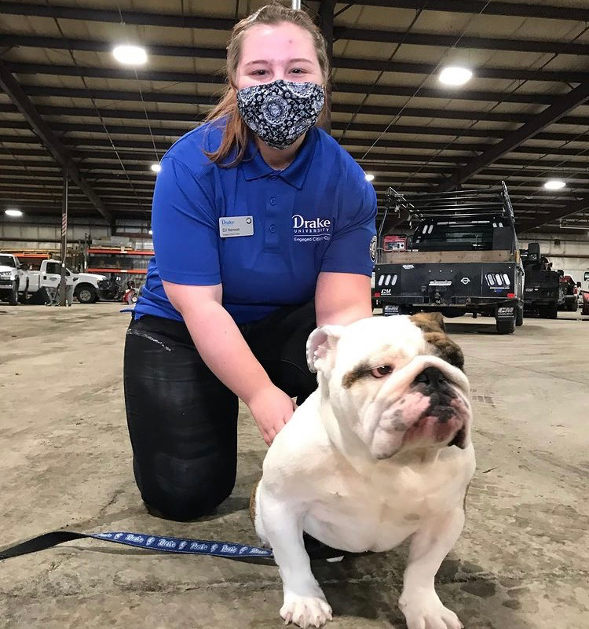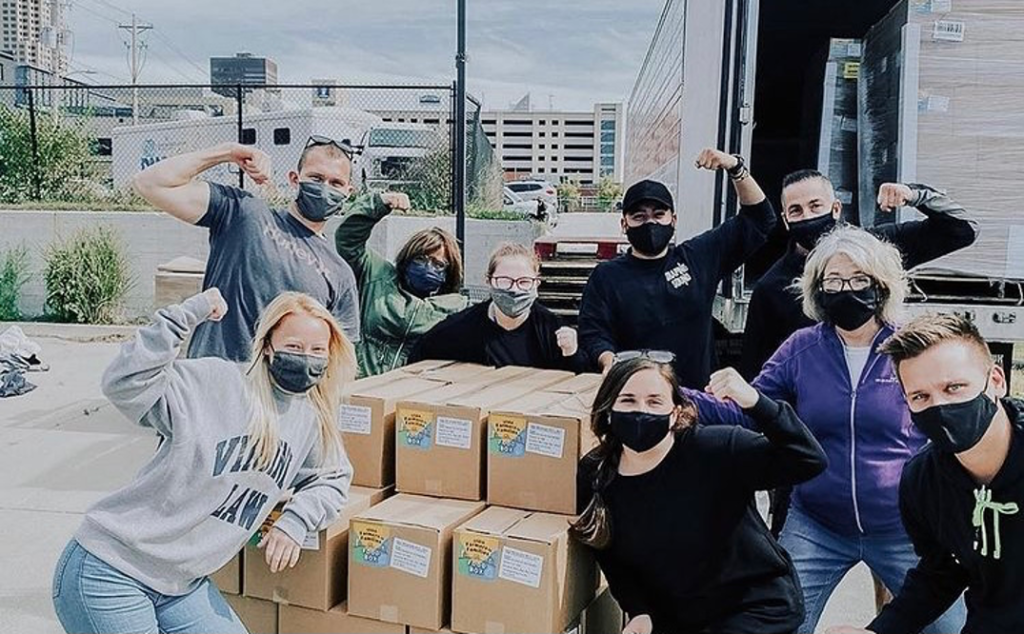DJ Henson, Engaged Citizen Corps Member
Hi! I’m DJ Henson (she/her/hers). I am studying Physics, Astronomy and Mathematics at Drake, and I am highly involved on the Drake campus through the Engaged Citizen Corps, Student Alumni Association, Honors Executive Council and Interfaith at Drake!

I have been blessed with the opportunity to work with Eat Greater Des Moines (EGDM) the past few months, helping to create a more equitable and quality food system for all. While EGDM addresses food insecurity through three main approaches—double-up food bucks, community garden support and food rescue—my team and I have been tasked with creating a new initiative that will allow passionate individuals in our community to engage in food rescue programs with the Central Iowa Food Recovery Network!
What is food rescue?
To put it simply, food rescue (also known as food recovery) is the act of obtaining edible, but unsellable, food from businesses in order to redistribute it in the emergency or supplemental food system so it is put to use instead of wasted.
However, the reality is that food rescue is much more complex than this. Many businesses would prefer to throw out their unsellable foods—even though waste removal costs a considerable sum of money—rather than risk potential lawsuits for injuries related to their donated food. This fear, however, is entirely unfounded for two reasons:
- The dating system used on foods is based on quality, not safety.
- Federal law and Iowa state law protect donor businesses who participate in food rescue in good faith.
Now, what does that mean? It means that once that tub of yogurt on the store shelf reaches its printed date, it is still entirely safe to consume, so long as there are no signs of obvious spoilage. It also means that the same tub of yogurt past its date can be safely rescued and put in a community fridge or food bank with no possibility of legal trouble for the donating business, so long as there are no observable signs of tampering or spoiling.
So why aren’t more businesses participating in food rescue? I can assure you, I had never heard the term “food rescue” before partnering with EGDM, much less observed it in action. The more research I did on the topic, the more I discovered the clear benefits of food rescue for donor businesses, food rescue services and emergency food infrastructure alike. Donor businesses can not only save on waste disposal costs, but can also claim their donations as a tax write-off, saving millions of dollars annually for regular donors. Food rescue services, like EGDM, employ delivery drivers and rescue coordinators, providing jobs for the community. Food pantries receive quality, wholesome food on a regular and consistent basis, which allows for a more nutritious and stable emergency food system for the food insecure. All of these contribute to a thriving community. And yet, so much edible food ends up in landfills every year. The issue here is a lack of understanding and awareness.
This is where my team comes in. We have set out to create a more informed public, which can in turn encourage local businesses to participate in food rescue initiatives. Teaming up with local high schools and the Central Iowa Food Recovery Network, we are creating a Food Rescue Ambassador Program that will allow the leaders of tomorrow to create change in our food system today. We believe in the power of young voices and fresh perspectives, and we know that our local students will become great agents of change for our city.
What does food rescue look like?
Truthfully, I do not know what food rescue normally looks like. I have only ever experienced it in the midst of a global pandemic—which, from my perspective, has not only exacerbated the need for a quality food system, but highlighted the need for reformation of an already strained emergency food network.
How have operations changed? I have yet to step foot inside a pantry or community fridge since working with EGDM. Though I have, on several occasions, stood outside of one in the rain or the beaming sun, arms full of donated day-old Kum & Go sandwiches, waiting for someone to pop their head in the window to acknowledge the arrival of their rescued food. Almost all food rescue operations have shifted to being contactless in the wake of the COVID-19 crisis. Masks are worn at all times, even when not in contact with anyone else. Safety is of utmost importance for EGDM, so our operations rapidly shifted to meet the growing demand for safety.

How has need changed? During my site orientation (over Zoom, back in early September) my supervisor mentioned that Eat Greater Des Moines had already moved over double the food at that point than they had in the entire year before—and there were still three months left in 2020. That only goes to show that the Coronavirus pandemic has created a deeper need for food in our city. More people than ever rely on the emergency food system to survive these incredibly trying times, and EGDM has been working nonstop to create a bountiful supply of quality food. To learn more about Eat Greater Des Moines and how you can get involved, visit https://www.eatgreaterdesmoines.org/.
Where do I fit in?
This experience has been life-changing for me. I have always considered myself a “foodie,” but now I see food in a whole new light, and creating food equity has become one of my greatest passions, and most exciting opportunity professionally. As a STEM major, particularly a mathematics and logic-based STEM major, my skillset that I develop in the classroom lends itself perfectly for thinking outside the box to create meaningful and long-lasting change in the world.
My biggest takeaway from my experience at Eat Greater Des Moines and through the Engaged Citizen Corps is a saying I have heard ever since I was young: “if it ain’t broke, don’t fix it.” Looking past the questionable grammar, this phrase has deep meaning in community-based work. Struggling communities rarely benefit in the long-term from hand-outs and outside help alone. If a community is struggling consistently for long periods of time, it is because the community does not have the capacity to help itself—yet. It is important to use existing infrastructure and local expertise to create a truly meaningful system of escaping poverty—not just handing over the things that we may perceive the community in question needs.
In closing, it is important to remember that everyone from all walks of life and all types of skillsets can engage in meaningful work for the betterment of our communities, nations and our world. Finding where you fit in—and where you’re better off letting someone else take over—is the most challenging and the most necessary step to creating change. If you’re unsure of what that step may look like, I encourage you to reflect on your experiences, your failures, your triumphs and your dreams, and look to those around you with similar backgrounds and aspirations. Those are the people who will help you change the world.